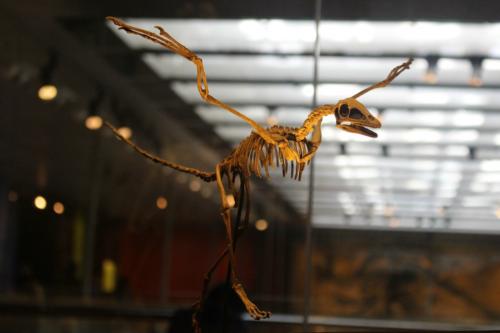
Birds are dinosaurs. That’s a fact underscored by dozens upon dozens of discoveries in the last 30 years. Free of the historic blinders that cast dinosaurs as monstrous reptiles, we’re now gaining an ever-greater appreciation for how bird-like Tyrannosaurus and its famous relations really were.
In fact, many traits we think as unique to birds evolved hundreds of millions of years ago. Reproduction by laying shelled eggs goes back to some of the first vertebrates to carve out a living on land, around 315 million years ago. Fluffy body coverings might go back to the earliest dinosaurs. And air sacs that radiate out from the respiratory system into bone go back to the last common ancestor of dinosaurs like Apatosaurus and Allosaurus, at least.
But what about flight? More than anything else, the ability to take to the air seems to distinguish birds from most of the extinct dinosaurs, and this is where the picture starts to get a little fuzzy. For symbolic reasons, at least, avian flight marks the arrival of something new and different on the evolutionary scene, and paleontologists have spent over a century trying to tease out the transition.
The latest entry into the field was just published by Yale University researchers Teresa Feo, Daniel Field, and Richard Prum. They focused on one particular part of dinosaurian anatomy – asymmetrical feathers.
The presence of asymmetrical wing feathers – with a short leading edge and longer trailing edge, such as the primaries on the wing – has often been taken as a rough proxy for some kind of flying behavior in extinct, feathered creatures. That’s because this shape helps create lift. As Feo and colleagues point out, though, associating a general shape with the ability to fly is too coarse an interpretation. Many flightless birds have asymmetrical feathers that they inherited from their flying ancestors, including streamlined penguins that flap through the water. In order to tease out the clues of how these feathers contributed to flight, researchers have to comb over the plumage in closer detail.
Feo, Field, and Prum looked to geometry to see how the feathers of non-avian dinosaurs like Microraptor compared to those of early birds, such as Archaeopteryx, and their living relatives. Specifically, the researchers zeroed-in on the angles and lengths of asymmetrical feather barbs – the shafts that run perpendicular to the central rib that the rest of the feather branches out from. Given that the length and the angle of the feather barbs alter flight ability, Feo and coauthors could come up with a better idea of how skilled extinct dinosaurs would have been in the air.
In some ways, the primaries of Archaeopteryx and Microraptor were like those of other birds, including living species. The barbs on the “cutting edge” of their feathers were held at small angles relative to the shaft they branched from. This kept the leading edge of the feather relatively rigid and better for pitch control. But, on the trailing edges of their feathers, Archaeopteryx and Microraptor were different from flying birds.
Along the trailing edge of the primaries, Feo and coauthors point out, the barbs of flying birds are positioned at relatively large angles. This helps gives the feathers flexibility and maintain a stable airfoil. But in Archaeopteryx and Microraptor, the trailing-edge barbs were held at small angles. This kept their primaries stiff and less responsive, limiting their degree of flight control.
From their fossil sample, Feo and colleagues hypothesize that “modern” asymmetrical feathers with small leading and trailing barb angles first evolved in early, toothed birds like Confuciusornis and Eopengornis, around 125 million years ago. Along with other traits that evolved around the same time – such as a “winglet” called the alula and expanded bony keel – the barb angles hint that these birds really were flying.
But what about Archaeopteryx and Microraptor? Paleontologists have gone back and forth over whether or not these dinosaurs could fly for years. The emerging consensus is that they were able to move through the air somehow, but perhaps not in a way that would be familiar to us. While they weren’t capable of the “modern avian flight stroke” – the crux of these investigations – Archaeopteryx and Microraptor may have used some combination of gliding and flapping. Watching an airborne Archaeopteryx must have been quite a sight, and, from feather and bone, that is exactly what many paleontologists are trying to envision.
Reference:
Feo, T., Field, D., Prum. R. 2015. Barb geometry of asymmetrical feathers reveals a transitional morphology in the evolution of avian flight. Proceedings of the Royal Society B. doi: 10.1098.rspb.2014.2864
